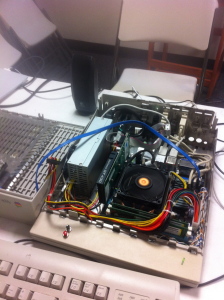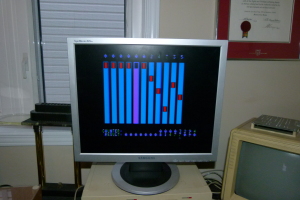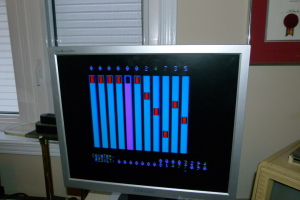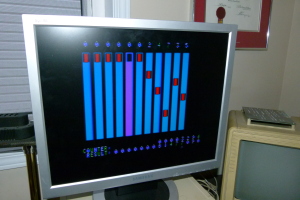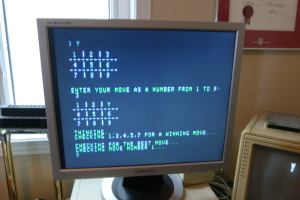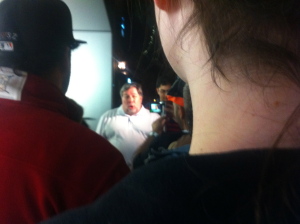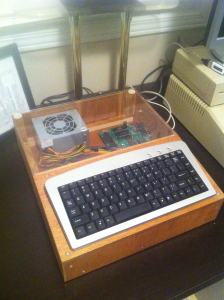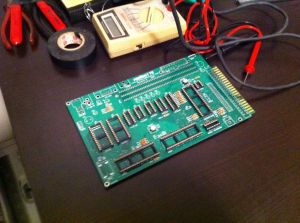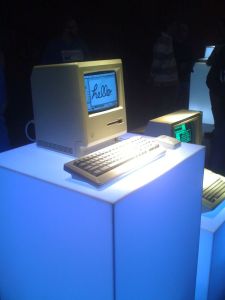With Samantha about to start in the competitive gymnastics program, we really needed to have a better way to monitor her blood sugar. In the recreational program which she has been a part of until now, Cynthia or I would sit in the waiting room. She would stop by and let us test her if she felt low. With the activity, she did tend to drop during her gymnastics classes.
But for the competitive program, the coaches really do not want the parents sitting in the waiting area and potentially distracting the girls. I am sure they would make an exception for us but we wanted to give Samantha some more space. At the same time, we knew that gymnastics was one of those times that her blood sugar needed to be watched closely.
We decided to get a continuous glucose monitor for Samantha. There is a sensor which is inserted into her skin and replaced every several days. A transmitter sits on top of the sensor and send the readings every five minutes to a receiver wirelessly. The receiver has a screen and you can look at recent readings and trend arrows that tell you how her sugar is changing.
The receiver needs to be within about 20 feet or so though. To make the next jump, we used something called NightScout. NightScout is a project by several people online to piece together a way to monitor blood sugar remotely. You connect the receiver to a cell phone using a USB cable. The cell phone runs a special app which reads the blood sugar readings from the receiver and sends them out to a database you setup on the Internet. You also setup a web server on the Internet which reads the database and presents the readings to a web browser. Then, there are apps for the iPhone and other devices which display the data.
The NightScout setup instructions describe how to setup a database and a web server on two different hosting platforms. Initially, I setup services on these other hosting platforms. I did this so I could at least test everything and ensure it was all working. Easiest to follow the instructions exactly the first time. Once I saw how it actually worked, I was ready to do it my way.
I have had my web hosting with Dreamhost for years and I really didn’t want to suddenly use a bunch of other services. First, I needed to move my existing web sites (including this one) from their shared servers to a VPS (virtual private server). The web server for NightScout is node.js based and will not work from a shared server. Dreamhost moved my existing websites to the VPS without a hitch.
Next, I setup the NightScout database on my new VPS. I redirected the cell phone to send the readings to my new database and sure enough, I started getting data. I changed the web server (still at the non-Dreamhost server) to get its data from my VPS hosted database and that worked. Now I needed to move the web server.
I grabbed a copy of the Javascript source for the node.js server and poked around for bit. The instructions have you use these other hosting services partly because they are cheap but also they have nice interfaces for configuring everything. I was working from a command line into my VPS and trying to figure out how to configure things. When the instructions said to set a field in a form to X, what do I need to do in order to accomplish the same thing.
After browsing the code for the server a bit, I wrote a simple script to setup some config options and launch the server. After a couple of tries, I got the script right and the server started working.
With that up, I changed Cynthia’s and my phone to pull data from the server running on our VPS. I decommissioned the services I setup with the other providers. The entire solution was now running through a VPS I managed. I wrote a backup script to make sure all of this configuration was backed up every night. The backups go back to our computer at home.
We even bought a Pebble watch for Cynthia which lets you have the blood sugar readings right on the screen of the watch. So, here is the sequence of events to get blood sugar readings to us:
- The sensor takes a blood sugar reading.
- The transmitted connected to the sensor sends that reading to the CGM receiver wirelessly.
- The cell phone pulls that reading from the CGM receiver through a short USB cable.
- The cell phone uploads the reading to the database running in our VPS.
- The web server on our VPS provides that reading and all other data to any client which requests it.
- Our iPhones have apps on them which will communicate with the web server on the VPS and display the blood sugar values and trends in real time.
The only requirement is that the receiver/cell phone stay within about 20 feet of Samantha and that the cell phone has a good Wifi or cell signal so it can upload the data. This will be how we give Samantha more independence while also continue to be able to manage her blood sugar.
